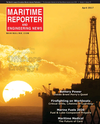
Page 11: of Maritime Reporter Magazine (April 2017)
The Offshore Annual
Read this page in Pdf, Flash or Html5 edition of April 2017 Maritime Reporter Magazine
individual, often now up for more than about to give everyone a lot of trouble. If sulphur requirements, that piece of paper what the ballast water equivalent to that 24 hours and owing to the scaled over- shipowners aren’t worried about it, well, may not be worth the paper it is printed term might be. It turns out that no one time rates then in force, might be making they should be. on when the ECA ? ag state at your next else knows, either. Eventually, we’ll all as little as $3.00 per hour. You can only Like the bunkers you lifted in good disport comes on board and says that you ? nd out together, I suppose. I also have imagine the highly motivated and com- faith in the Far East that came complete are out of compliance. An apples-to-or- this creepy feeling that it’s going to be petent fashion with which those samples with a beautiful analysis report (remem- anges comparison? I think not. very expensive, when we do. Brace were pulled, labeled, sealed and (? nally) ber our ‘crack’ sampling crew?) that de- In the petroleum trades, it is called a yourself. delivered to the gleaming lab across the tails full compliance with the new low “representative sample.” I’m not sure – MarPro.
channel.
That’s not to say the traders weren’t aware of their exposure. They were.
Sometimes, in between squash matches at the Texas Club in downtown Houston, they’d even pause long enough to yell at me. Meanwhile, in the absence of an au- tomatic in-line sampler, manual samples typically involved ? ve different methods – an upper sample, lower, middle, run- ning average (a skill unto itself if done properly and it rarely was) and what was called a “dead bottom” sample, taken with a special device. I remember one very particular blender who insisted on a seven step sampling process, something the sampling dudes referred to derisively (probably because it delayed their arrival at the bar on I-10 in East Houston by at least 30 minutes) as a “TB-7.” TB, of course, were the initials of the blender.
We’ll leave it at that.
All of those samples, once received by the lab, would then be meticulously and volumetrically combined to form one ‘representative’ sample, which was then tested and deemed to represent the qual- ity of the entire million barrel cargo. And for all the technology, gleaming equip- ment and highly trained lab technicians, in the end, the analysis was only as good as the samples (usually) taken by a sleepy guy working his way towards his GED in his spare time when he wasn’t getting dirty on deck. Those analysis numbers also relied on the ‘hope and prayer’ that the inspector’s sampling kit and bottles hadn’t been rolling around in the back of a dirty and wet pickup truck for the past week. And that brings us right back to your treated ballast water samples.
Looking Ahead
It was a pretty good ballast water con- ference. I’ve been to it before, of course, and you always learn something new. A key take-away from this year’s version was the murky subject of sampling, when that might be required, how it would be done, who would do it and all the rest of it. It turns out there isn’t a clear consen- sus of what this will entail in the future, and as outlined above, it may be more important than the installation of the equipment itself. Based on my consider- able experience – that and $4.50 will get you a hot beverage at a high end coffee chain – I believe that this aspect of the
BWT equation is a can of worms that is www.marinelink.com 11
MR #4 (10-17).indd 11 MR #4 (10-17).indd 11 4/4/2017 3:31:19 PM4/4/2017 3:31:19 PM

 10
10

 12
12
